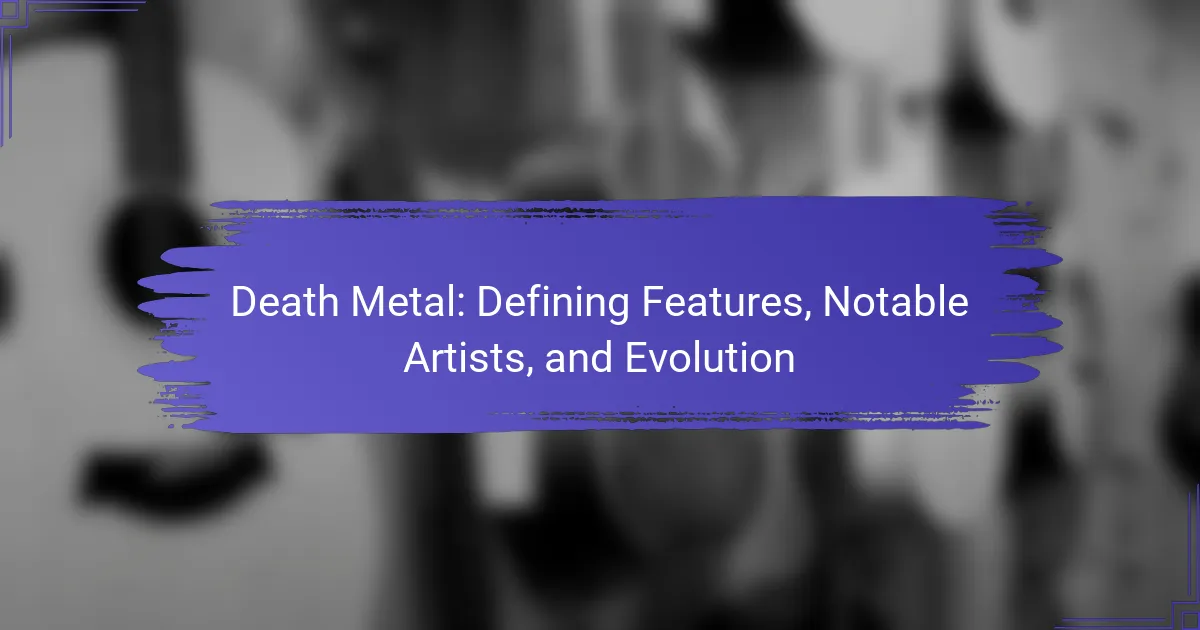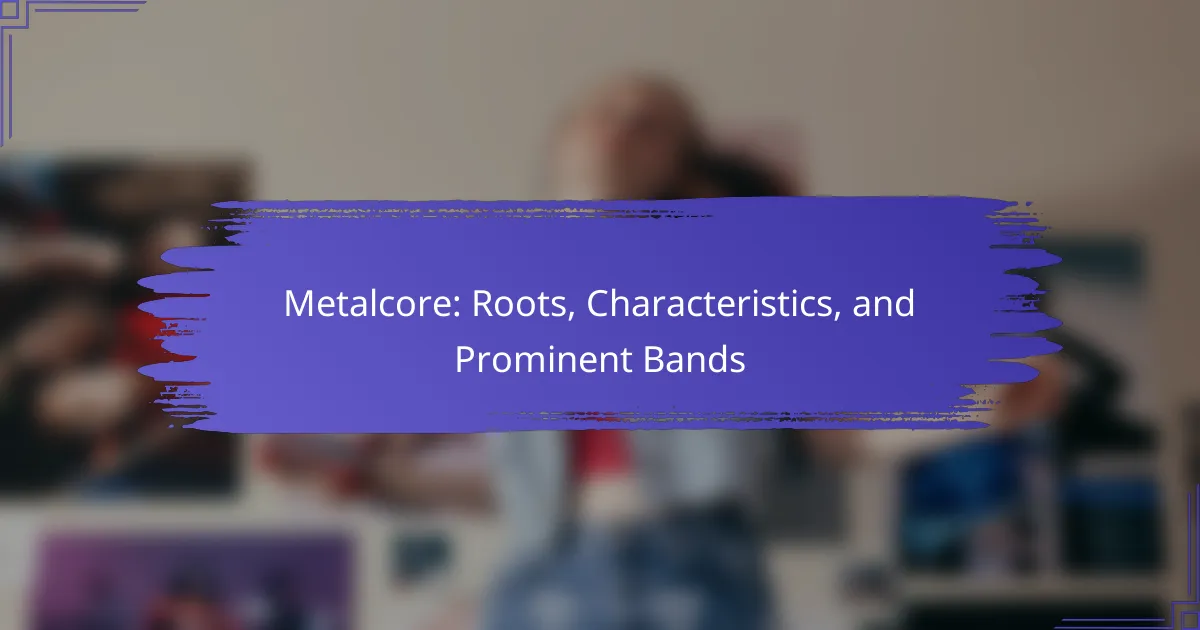Groove metal stands out in the metal genre with its heavy, rhythmic riffs and strong emphasis on groove. This article explores its defining traits, influential albums like Pantera’s “Vulgar Display of Power,” and key artists such as Sepultura and Lamb of God. Understanding these elements reveals groove metal’s unique identity and its evolution within the broader metal landscape.
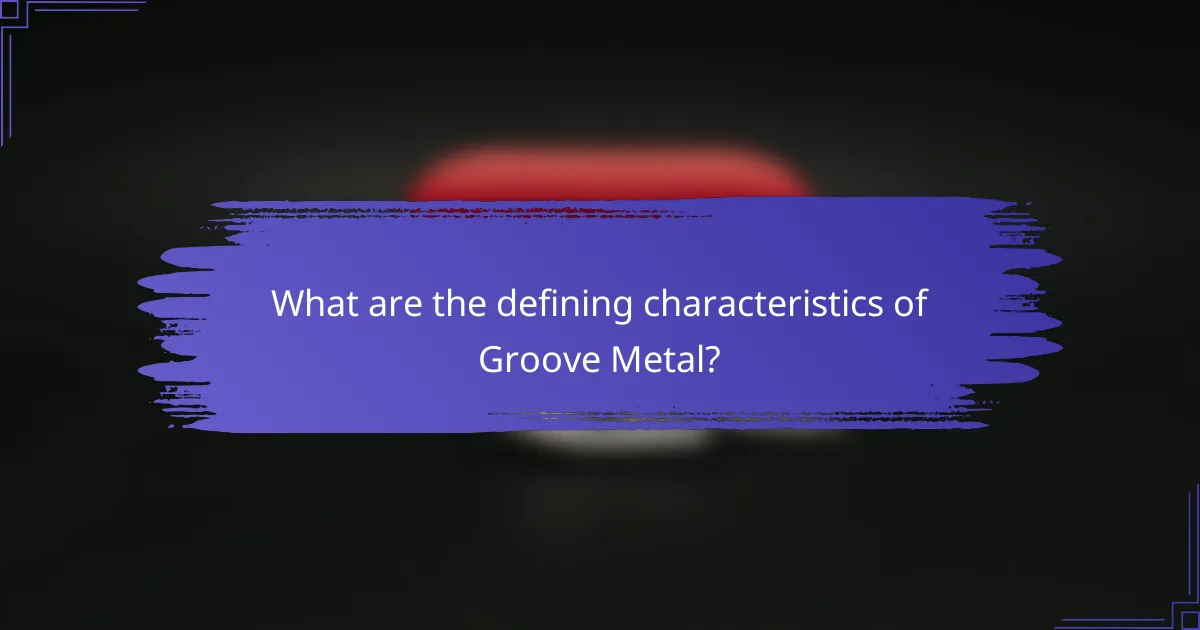
What are the defining characteristics of Groove Metal?
Groove metal is characterized by its heavy, rhythmic riffs and a strong emphasis on groove. This genre often combines elements of thrash and heavy metal, featuring down-tuned guitars, syncopated rhythms, and aggressive vocals. Influential albums like “Vulgar Display of Power” by Pantera exemplify these traits, showcasing powerful grooves that drive the music. Key artists such as Sepultura and Lamb of God further define this genre with their unique interpretations, blending various musical influences while maintaining the core groove metal sound.
How does Groove Metal differ from other metal genres?
Groove metal stands out from other metal genres through its emphasis on rhythm and groove over speed and technicality. This genre incorporates heavy, syncopated riffs and a strong emphasis on the downbeat, creating a distinct, headbanging feel.
Notable attributes include its slower tempo compared to thrash metal and its focus on rhythmic patterns, often borrowing elements from funk and blues. Influential albums like “Vulgar Display of Power” by Pantera and “Roots” by Sepultura exemplify groove metal’s unique sound. Key artists such as Lamb of God and Sepultura further define this genre with their signature grooves and powerful live performances.
What rhythmic elements are essential to Groove Metal?
Groove Metal relies on heavy, syncopated rhythms and a strong emphasis on the downbeat. Essential elements include palm-muted guitar riffs, aggressive drumming patterns, and a focus on groove over speed. These components create a distinct, powerful sound that defines the genre. Notable bands like Pantera and Sepultura exemplify these rhythmic characteristics in their influential albums.
Which lyrical themes are commonly explored in Groove Metal?
Groove metal commonly explores themes of aggression, social issues, and personal struggles. Lyrical content often reflects anger towards societal norms, existential dilemmas, and personal conflict. The genre’s focus on rhythm and groove complements its exploration of intense emotions. Additionally, themes of rebellion and empowerment frequently surface, resonating with listeners seeking catharsis.
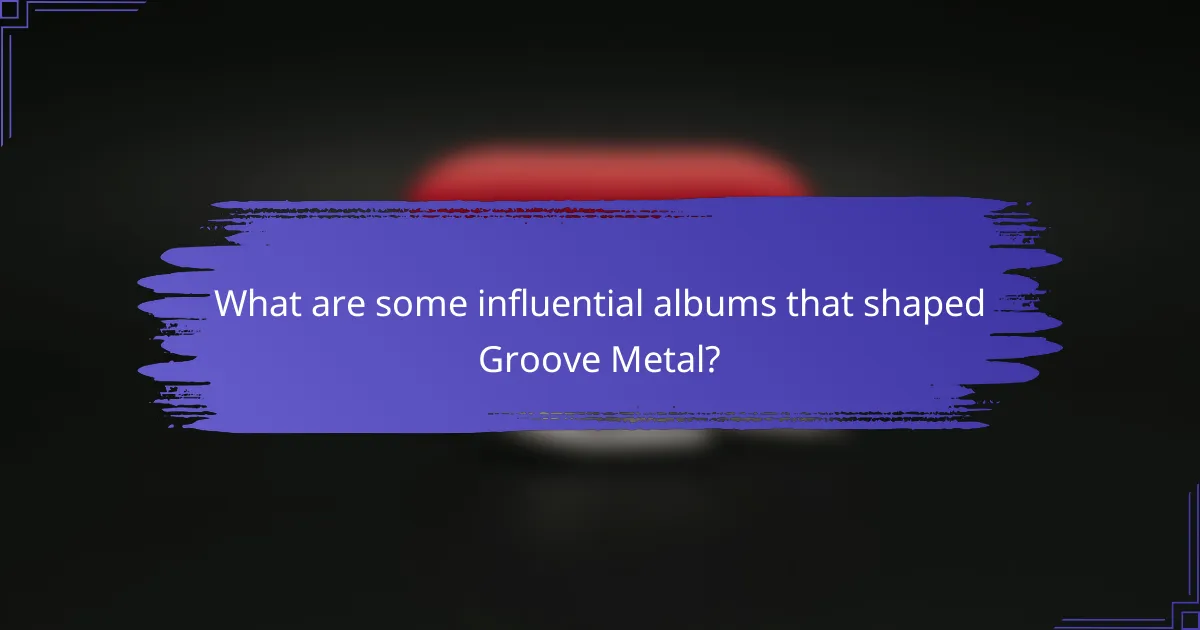
What are some influential albums that shaped Groove Metal?
Some influential albums that shaped Groove Metal include “Vulgar Display of Power” by Pantera, “Chaos A.D.” by Sepultura, and “Burn My Eyes” by Machine Head. These albums introduced heavy rhythms and aggressive riffs, defining the genre’s sound. “Vulgar Display of Power” features powerful tracks like “Walk” and “Mouth for War,” showcasing the unique attribute of groove-oriented guitar work. “Chaos A.D.” blends tribal elements with metal, while “Burn My Eyes” emphasizes raw energy and lyrical depth. Each album has left a lasting impact on the genre and its evolution.
Which albums are considered essential listening for Groove Metal fans?
Essential albums for Groove Metal fans include “Vulgar Display of Power” by Pantera, “Chaos A.D.” by Sepultura, “Burn My Eyes” by Machine Head, “The Great Southern Trendkill” by Pantera, “Soul of a New Machine” by Fear Factory, and “Obsolete” by Fear Factory. These albums define the genre’s sound through heavy riffs and rhythmic intensity.
How did specific albums influence the evolution of the genre?
Specific albums significantly shaped groove metal by introducing distinct rhythms and aggressive tones. Notable examples include “Cowboys from Hell” by Pantera, which popularized the genre’s signature sound, and “Chaos A.D.” by Sepultura, known for its blend of thrash and tribal elements. These albums emphasized heavy guitar riffs and syncopated drumming, influencing countless artists. Their innovative approaches helped define groove metal’s identity and pushed the genre’s boundaries, leading to its evolution.
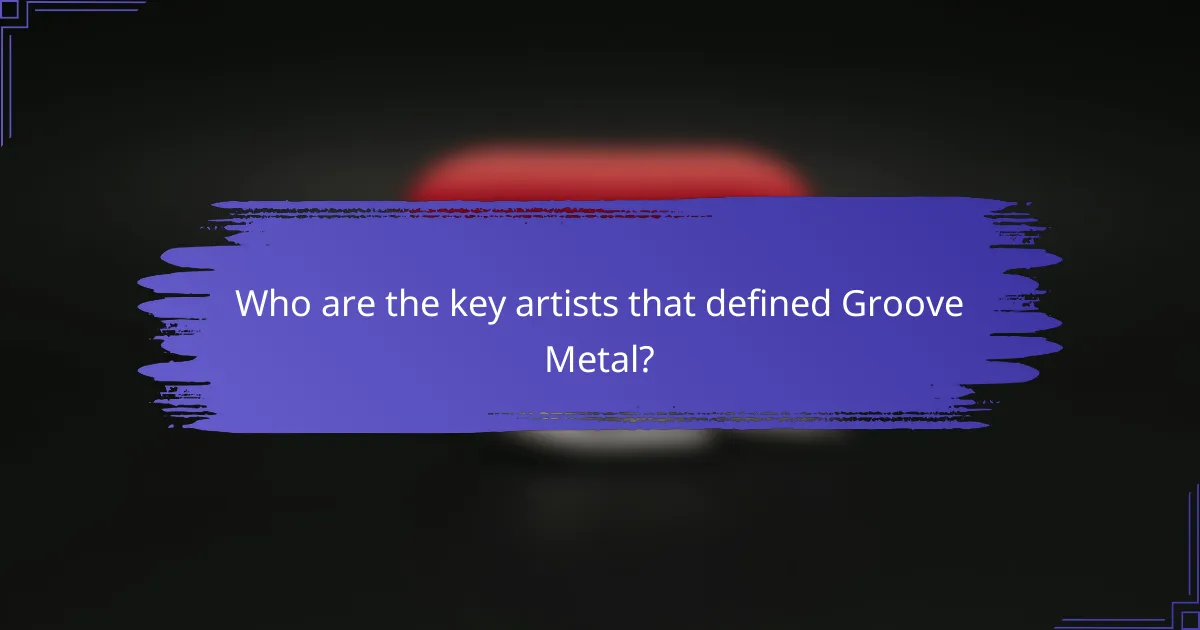
Who are the key artists that defined Groove Metal?
The key artists that defined Groove Metal include Pantera, Sepultura, and Lamb of God. Pantera’s “Vulgar Display of Power” showcased aggressive rhythms and powerful riffs, setting a benchmark for the genre. Sepultura’s “Roots” blended tribal elements with heavy grooves, expanding the genre’s boundaries. Lamb of God’s “Ashes of the Wake” exemplified modern groove metal with intricate guitar work and dynamic vocals. Other notable mentions are Machine Head and Soulfly, who contributed significantly to the genre’s evolution.
Which bands are recognized as pioneers of Groove Metal?
Pantera, Sepultura, and Lamb of God are recognized as pioneers of Groove Metal. These bands significantly influenced the genre with their heavy riffs and rhythmic complexity. Pantera’s album “Vulgar Display of Power” is often cited as a defining work, showcasing the genre’s signature sound. Sepultura’s “Roots” further expanded the groove metal landscape by incorporating tribal elements. Lamb of God’s “Ashes of the Wake” solidified their status with aggressive yet melodic compositions.
What contributions did individual artists make to the genre?
Individual artists significantly shaped groove metal through distinctive styles and contributions. Pantera’s Dimebag Darrell introduced heavy riffs and aggressive solos, while Sepultura’s Max Cavalera infused tribal rhythms. Machine Head’s Robb Flynn contributed dynamic songwriting and a blend of aggression and melody. Lamb of God’s Randy Blythe brought a unique vocal style that emphasized intensity. Each artist’s unique attributes helped define the genre’s sound and influence.
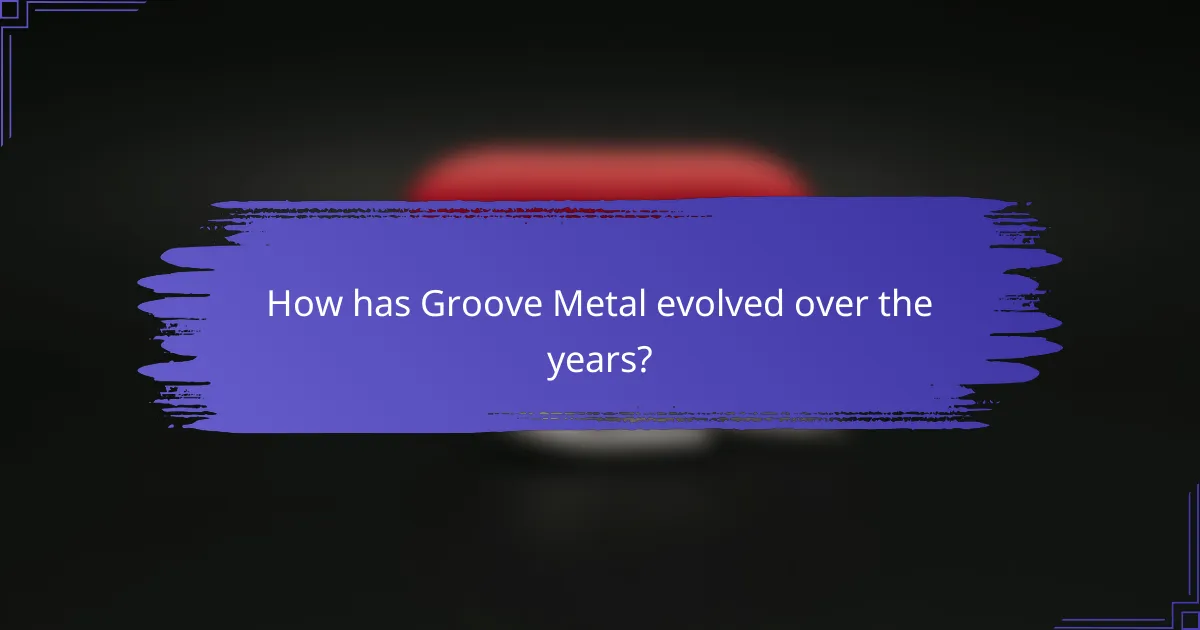
How has Groove Metal evolved over the years?
Groove metal has evolved by incorporating diverse influences and expanding its sound. Initially emerging in the late 1980s, it fused elements of thrash metal and hardcore punk. Key albums like Pantera’s “Vulgar Display of Power” and Sepultura’s “Roots” defined its aggressive yet rhythmic style. Over the years, bands like Lamb of God and Machine Head have further shaped the genre, introducing melodic elements and complex rhythms. This evolution reflects changing musical landscapes while maintaining groove metal’s core identity.
What contemporary bands are carrying the Groove Metal torch?
Contemporary bands carrying the Groove Metal torch include Lamb of God, Pantera, and Machine Head. These artists embody the genre’s signature rhythms and heavy riffs. Lamb of God released “VII: Sturm und Drang,” showcasing their modern take on groove metal. Pantera’s influence remains strong, inspiring new acts with albums like “Vulgar Display of Power.” Machine Head continues to innovate, blending elements of groove with other genres.
How has technology influenced the production of Groove Metal?
Technology has significantly enhanced the production of Groove Metal by enabling innovative sound manipulation and recording techniques. Digital audio workstations allow for precise editing and layering of guitar riffs, creating the genre’s signature heavy sound. Additionally, advancements in amplifier technology and effects pedals have provided artists with more diverse tonal options. The internet has facilitated collaboration among musicians globally, leading to unique influences and styles within the genre. Streaming platforms also broaden accessibility, allowing Groove Metal to reach wider audiences. Overall, technology has transformed both the creative process and distribution methods in Groove Metal.
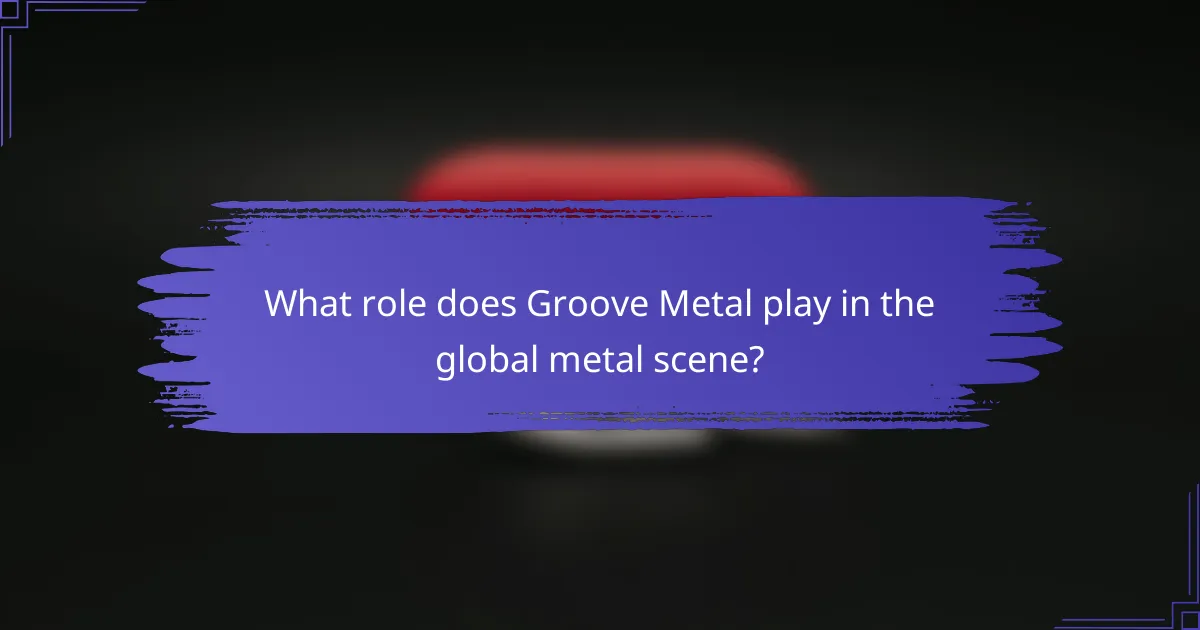
What role does Groove Metal play in the global metal scene?
Groove Metal plays a significant role in the global metal scene by blending heavy riffs with rhythmic grooves. This subgenre has influenced numerous bands and shaped the sound of modern metal. Key attributes include its focus on rhythm over speed, which creates a unique listening experience. Influential albums like “Vulgar Display of Power” by Pantera and “Chaos A.D.” by Sepultura showcase its impact. Notable artists, such as Machine Head and Lamb of God, have further solidified its presence, contributing to a diverse and evolving metal landscape.
How is Groove Metal perceived in different regions?
Groove Metal is perceived differently across regions, influenced by local music scenes and cultural contexts. In the United States, it emphasizes heavy riffs and rhythmic grooves, with bands like Pantera leading the charge. European countries often blend Groove Metal with melodic elements, as seen in the works of bands like Soilwork. In South America, particularly Brazil, the genre thrives with a vibrant live scene, showcasing local talent. Asian regions, such as Japan, incorporate Groove Metal into diverse genres, reflecting unique cultural influences. Each region’s interpretation adds depth to Groove Metal’s global identity.
What festivals and events celebrate Groove Metal?
Several festivals and events celebrate Groove Metal, highlighting its vibrant community. Notable examples include the “Metallica’s Orion Music + More Festival,” showcasing various metal subgenres, and “Download Festival,” which features prominent Groove Metal bands. Additionally, “Hellfest” in France often hosts Groove Metal acts, emphasizing the genre’s influence. These events provide fans with opportunities to experience live performances and connect with like-minded enthusiasts.
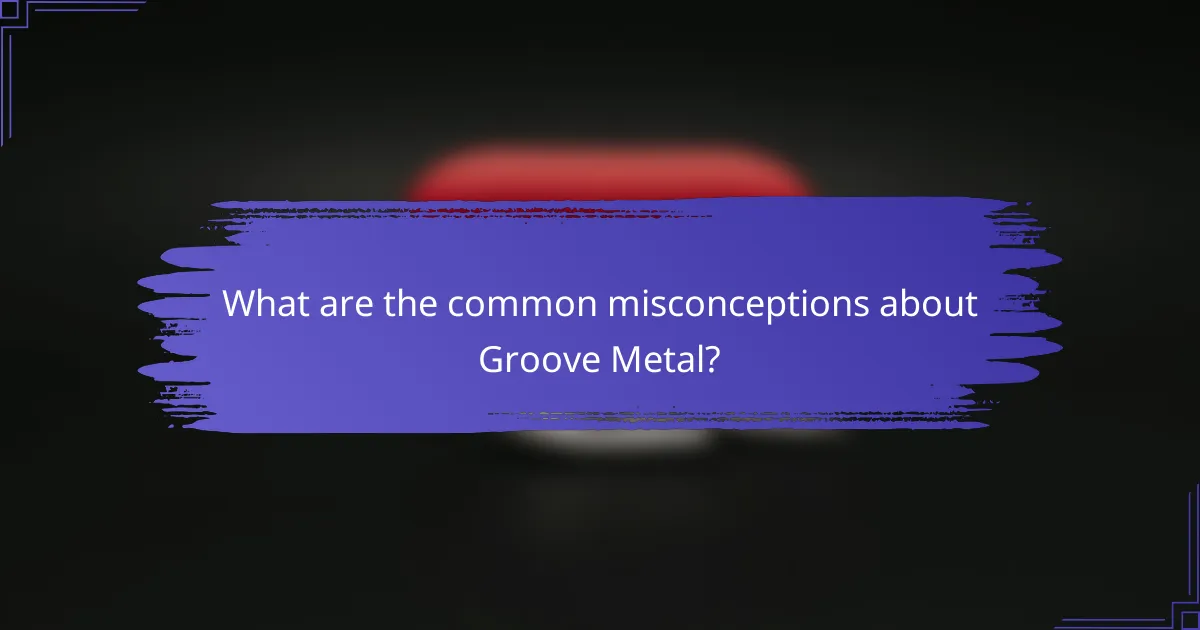
What are the common misconceptions about Groove Metal?
Common misconceptions about Groove Metal include the belief that it is solely a subgenre of Thrash Metal, its association only with heavy guitar riffs, and the idea that it lacks musical complexity. Groove Metal distinctively incorporates rhythm and groove, often blending influences from other genres like funk and hardcore. Additionally, some think it is a recent phenomenon, while key albums from the 1990s, such as Pantera’s “Vulgar Display of Power,” showcase its roots. Understanding these misconceptions clarifies Groove Metal’s unique identity within the broader metal landscape.
Why do some critics dismiss Groove Metal?
Some critics dismiss Groove Metal due to its perceived lack of complexity and reliance on repetitive rhythms. This genre often emphasizes heavy, syncopated guitar riffs and a strong, driving beat, which some argue oversimplifies musical composition. Critics may also view its mainstream appeal as a dilution of metal’s traditional values. Additionally, the blending of Groove Metal with other genres can lead to a perception of inconsistency and a loss of the raw energy that characterizes heavier metal subgenres.
How can fans of other genres appreciate Groove Metal?
Fans of other genres can appreciate Groove Metal by focusing on its rhythmic complexity and emotional intensity. Groove Metal combines heavy riffs with intricate rhythms, often emphasizing a strong backbeat. Listening to influential albums like “Vulgar Display of Power” by Pantera showcases this unique sound. Key artists, such as Sepultura and Lamb of God, further exemplify the genre’s ability to blend aggression with groove. Exploring these elements can enhance appreciation for the genre’s artistic depth and musical innovation.
What are best practices for exploring Groove Metal music?
To explore Groove Metal music effectively, focus on key albums, influential artists, and distinctive sound characteristics. Listen to seminal albums like “Vulgar Display of Power” by Pantera and “Roots” by Sepultura. Familiarize yourself with prominent artists, including Lamb of God and Machine Head, who define the genre. Attend live performances to experience the genre’s energy. Engage with online communities and forums to discuss and discover new music.


